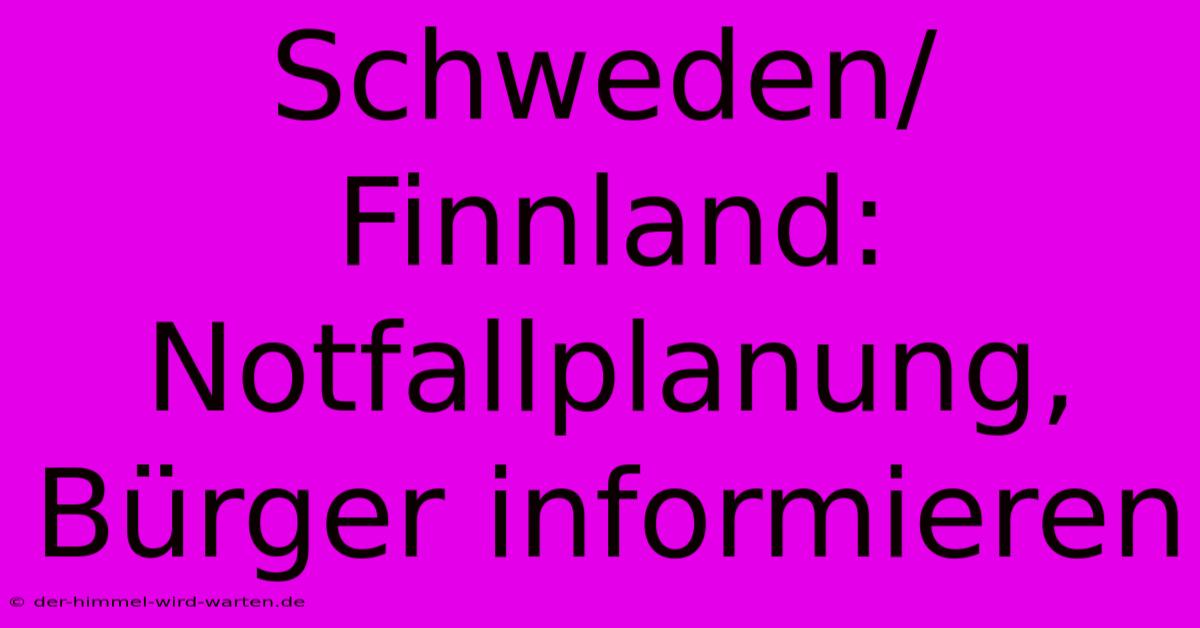Schweden/Finnland: Notfallplanung, Bürger Informieren

Discover more detailed and exciting information on our website. Click the link below to start your adventure: Visit Best Website Schweden/Finnland: Notfallplanung, Bürger Informieren. Don't miss out!
Table of Contents
Schweden/Finnland: Notfallplanung – Bürger informieren und vorbereitet sein
Hey Leute, let's talk about something super important, especially with everything going on in the world: emergency planning in Sweden and Finland. I mean, it's not exactly the most fun topic, but it's definitely one worth discussing. We need to be prepared, right? And knowing what to do in a crisis can be a lifesaver – literally.
I'll be honest, I used to totally gloss over this stuff. I figured, "What are the odds, right?" Wrong. Turns out, being proactive is key, especially if you live in, or are visiting, these amazing Nordic countries. Last year, during that crazy heatwave, I was totally unprepared. I had no emergency water, barely any non-perishable food. It was a wake-up call, let me tell you. I felt like such a doofus.
Why Emergency Planning Matters in Sweden and Finland
Sweden and Finland, while generally peaceful and safe, aren't immune to crises. We're talking about everything from severe weather events – think blizzards, floods, and those crazy summer heatwaves – to power outages, and even, you know, the less-likely-but-still-possible stuff. Having a plan reduces stress and improves your chances of staying safe. It’s crucial for both residents and visitors.
Practical Steps: Building Your Emergency Kit
So, what did I learn from my near-disaster? A lot, actually. Building an emergency kit is way easier than I thought. Seriously, don't overthink it. Start small, and build from there.
- Water: Aim for at least one gallon of water per person per day, for at least three days. That might seem like a lot, but it adds up fast!
- Food: Non-perishable stuff is your friend. Canned goods, energy bars, dried fruits – anything that'll last.
- First-aid kit: This should be well-stocked, with bandages, antiseptic wipes, pain relievers – the whole shebang. You can find pre-made kits or assemble your own.
- Flashlight and batteries: A must-have, especially during power outages.
- Radio (battery-powered): To stay updated on emergency information.
- Important documents: Copies of your passport, ID, insurance cards, etc. Keep them in a waterproof bag.
- Warm clothing: Even in summer, temperatures can drop unexpectedly.
- Cash: ATMs might not always be working during a crisis.
This isn't exhaustive, but it’s a great starting point.
Staying Informed: Official Channels and Resources
Staying updated on potential threats is half the battle. Both Sweden and Finland have excellent emergency alert systems.
- Sweden: Look into the Swedish Civil Contingencies Agency (MSB) website for alerts and guidelines. They have tons of information in English, too.
- Finland: The Finnish Emergency Supply Agency (Hätävarmuuskeskus) is your go-to source. They provide up-to-date information on emergencies and preparedness.
Subscribe to their alerts, check their websites regularly, and familiarize yourself with their advice.
Community Preparedness: Connecting with Neighbors
Okay, here’s something I didn’t realize was so important: connecting with your neighbors. Knowing your neighbours can make a huge difference during a crisis. It's about building a support network. Maybe you can check on elderly neighbors or help each other out with resources. Think of it as community-based emergency planning.
Beyond the Basics: Thinking Ahead
Honestly, I’ve learned that emergency planning isn’t a one-time thing; it’s an ongoing process. Regularly check and update your emergency kit. Practice your evacuation plan. And, you know, try not to be a total doofus like I was last summer. Learning from mistakes is part of the process, my friends.
So there you have it. Emergency planning in Sweden and Finland might not be glamorous, but it’s super important. Get prepared, stay informed, and connect with your community. You’ll be glad you did. Trust me on this one!

Thank you for visiting our website wich cover about Schweden/Finnland: Notfallplanung, Bürger Informieren. We hope the information provided has been useful to you. Feel free to contact us if you have any questions or need further assistance. See you next time and dont miss to bookmark.
Featured Posts
-
Finma Untersuchung Gegen Diverse Gesellschaften
Nov 20, 2024
-
Nadal Gegen Alcaraz Letztes Spiel
Nov 20, 2024
-
One Tree Hill Schauspieler Paul Teal Verstorben
Nov 20, 2024
-
Raumfahrt Panne Space X Kann Starship Nicht Retten
Nov 20, 2024
-
San Marino Der Kleinste Gigant
Nov 20, 2024
